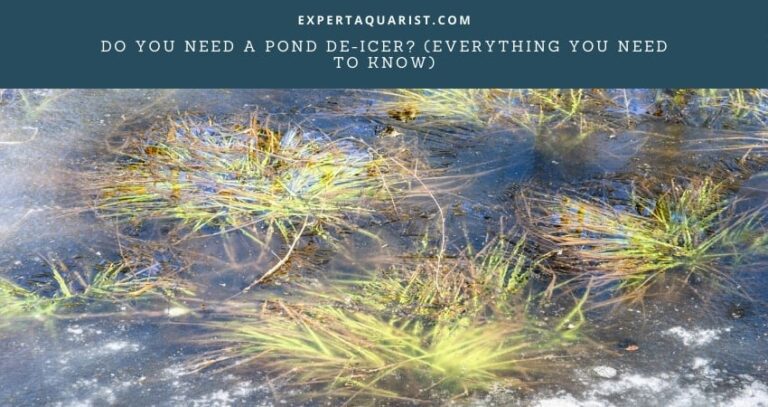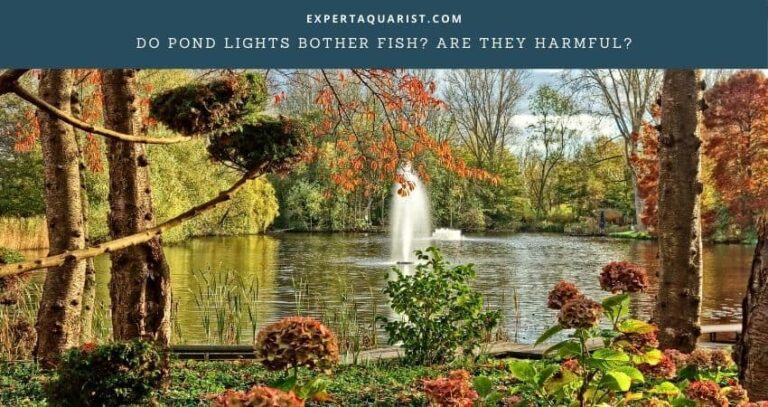While we enjoy all the snow and cold weather conditions of winter, our ponds despise it. Why so? Because it’s a critical time for them where the pond inhabitants risk losing their lives if the freezing gets uncontrolled.
I know what you’ll say, “just keep it heated”, am I right? But sometimes, it’s a little complicated. For example, the pond could be far from a power source, or the electrical bills could be too high. Luckily, there are some alternatives.
You can incorporate solar or fuel-powered devices to heat ponds. There are other ways too, like using an aerator or placing floating objects; even limiting the pond depth would work.
Want to know more about how to keep a pond from freezing without electricity? Head down below, please…
Understanding pond freezing
It’s a dreadful time for ponds when winter comes. The ponds’ natural ecosystem gets shaken up as the pond freezes because the gas exchange between air and water that seemed so normal is not so normal anymore.
The oxygen can’t enter the water, and the carbon dioxide generated from the respiration has nowhere to escape; all this is because the surface is sealed off.
At the same time, decomposers release gas like ammonia, hydrogen sulfide, carbon dioxide, etc. So, there is a lot of gas that has nowhere to go. Things worsen when oxygen production is hampered because sunlight has a hard time coming through thick ice.
In short, if you don’t do anything about a frozen pond in winter, you’re actively leading your pond inhabitants towards a slow death. But there is still hope; I’ll explain how.
The likelihood of your pond being frozen depends on the weather condition, so if you live in an area where the chances of freezing are less frequent, there is a possibility your pond might not get fully frozen.
And even if you live in a cold area where freezing occurs, there’s still pond depth to consider. Deep ponds are less likely to freeze completely.

If your pond doesn’t contain any fish, then freezing is not a significant threat to you if you let it be frozen. However, if you have fish like koi, you need to take good care of your pond.
But in case you do have fish in your pond, I’ve got some stuff for you that you can follow that’ll keep your pond unfrozen without using electricity. Let’s go:
Methods of saving your pond from freezing without electricity
If you follow one or more of these methods, you can keep your pond from freezing, and rest assured, you won’t need electricity for this.
1. Solar aerators
No electricity? Then go solar! This eco-friendly way of keeping your pond unfrozen is quite popular. We already discussed the importance of gas exchange in the water, which gives us an excellent opportunity to solve your worries.
The only downside is that it might not work properly if there’s no proper sunlight, but I’m sure you’re well aware of that.
Check out our article on pond aerators.
2. Fountains
For those who worry about appearances and aesthetics a lot, this is for them. It’ll float in the pond and draw water from the surroundings with the help of a pump; after gathering the water, it’ll spray it back using a nozzle.
While the water is being sprayed back, it absorbs the oxygen and takes it into the pond.
3. Submersible aerators
If you’re looking for a more professional output, this one is better. It stays submerged inside the pond and operates from there. It’ll collect air from the nearby atmosphere and supply it inside the pond through the tubing.
These are the most popular aerators in the market right now. It comes with a solar panel that you have to place where there is abundant sunlight.
4. Windmill
Let’s talk about the most Eco-friendly option out of them all, windmills. These fascinating structures are amazingly efficient while keeping the environment clean.
The best part about this is, you don’t need solar power or fuel to keep this going; it runs through the air. Incoming wind will push the fans of the windmill and will keep on moving until there is air.
Naturally, it’s not suitable in a place where there is no air. Windy areas on top of a hill are the best place to use this.
5. Pond heaters
Before you think I’m scamming you, listen to me please! Heaters don’t necessarily have to be run on electricity. What do we do when we don’t have electricity at home? We use fuel for power. We’ll do the same here!
Heaters are incredibly efficient in keeping the pond warm. There’s no fear of frozen ponds if it’s properly heated up. It has three goals: keeping the fish alive and comfy, allowing gas exchange, and increasing oxygen in the water.
The way it works is simple. It is enclosed in a chamber where it meets a heating element; afterward, when water passes through the chamber, heat exchange occurs, and water gets heated up.
The heated water will return to the pond, and the temperature of the pond will rise.
As long as there’s fuel, it’ll keep on heating the water. You’ll keep this up until your pond reaches your desired temperature. Use a thermostat to check every few minutes. However, modern heaters have it built-in.
If you have a large pond, I suggest getting a heater with a wattage of 1200.
6. Increasing pond depth
They say, “prevention is better than cure”. Smart pond owners would take the freezing into account before making the pond. A deep pond is excellent at regulating temperature.
During summer, it can remain cold, while in winter, it’ll stay warm. I can’t say the same for shallow ponds.
The fish in a deep pond can swim to a warmer area, but they don’t have that luxury in shallow ponds. Also, a deeper pond means the pond holds more water, so more oxygen. And we know how vital oxygen is, right?
For a fish pond, I recommend making it at least 18” deep. That is the bare minimum. But the sweet spot lies in between 8 to 12 feet.
But in case the thought of freezing didn’t occur to you when making the pond, you still have other methods; no need to worry.
7. Floating devices
One of the most effortless ways to keep your pond from freezing is by having floating objects that’ll make sure the pond isn’t completely frozen over, and there’s some space for gas exchange so that the fish can at least survive.
You’ll have to let the object float in the pond, and it should be light enough to be swayed by the wind. When the wind hits, it’ll move around and crack any ice trying to build up.
Saltwater bottles and volleyballs make excellent floating devices. Or, you could get an ice preventer or a de-icer.
If you follow one or more of these properly, you’ll successfully keep your pond safe.
More Tips On Pond Maintenance During Winter
Here are some additional tips that you can incorporate for a healthy pond:
Make a hole in the pond
Your pond needs to have oxygen; for the sake of the fish, this is set in stone. Otherwise, you’re looking at dead fish. There will be no entry path for oxygen to go inside the pond if the pond is frozen.
Make a hole in the frozen pond by pouring some hot water so that oxygen has a way to enter and gas exchange occurs. By doing this, you’re also maintaining sufficient oxygen for your fish.
Clean up the pond
To keep your pond healthy, you need to clean up at regular intervals. Things like fish poop or uneaten fish food as well as decaying matter can turn toxic for your fish.
The same can be said for fallen leaves, debris, or plant residues. So, don’t let it add up.
Don’t overfeed the fish
During winter, fish prepare for hibernation, so they try to eat less. If you keep feeding them as you did in summer, there will be a lot of uneaten food that could later turn into toxic compounds.
Also, you’ll interrupt the natural feeding habit of the fish; they might fall ill.
Avoid banging on the ice
Since banging would cause a vibration that’ll be carried over by the water, it could mess with the fish’s hibernation. You’ll most likely bang on it for making a hole; we already got a better way of doing it.
Prevent overheating
I know that a heater is essential for warming up the pond. But that doesn’t mean you need it to be on all the time. If it is on for more than the necessary amount of time, it could heat the pond a bit too much and harm the fish.
No more freezing
These were your in-depth suggestions about how to keep a pond from freezing without electricity. See? Very simple, nothing too grand. Just follow a few simple steps, and you won’t ever have to worry about your pond’s well-being in winter.
I’m sure you want the fish in your pond to enjoy winter as much as we do; well, they might even start to like winter now, who knows?






